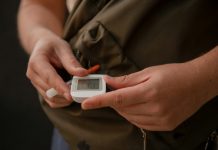
In a new guideline, researchers show how cardiac patients who also have diabetes can do their rehabilitation exercises more safely.
The guidance will be a crucial resource for healthcare professionals, so they can help the growing number of cardiac rehabilitation patients who also have diabetes.
The research was conducted by a team at Swansea University.
Physical exercise and improving activity levels are central parts of cardiac rehabilitation, which aims to boost the health and fitness of people with heart problems.
At present, around 25% of participants attending cardiac rehabilitation in Europe, North America and Australia also have diabetes.
This figure is increasing, largely because there are some common risk factors for both cardiovascular disease and diabetes, especially obesity and sedentary lifestyles.
While being more active is crucial for cardiac rehabilitation patients, a major obstacle is that many worry that the exercise itself will put them at risk.
For those patients who also have diabetes, however, there are additional worries, especially about falling blood sugar levels leading to hypoglycemia or low blood sugar.
Fear of having a “hypo”, which can lead to dizziness, disorientation, anxiety, and many other symptoms, is one of the main barriers stopping people with diabetes from incorporating exercise into daily life.
This helps explain why cardiac patients who also have diabetes have are less likely to take up and continue a cardiac rehabilitation program than those without diabetes.
This is where the new guidance can make a difference. It focuses on managing levels of blood sugar during rehabilitation activities, to reduce the risk of acute glycaemic problems during exercise.
The aim is to give more confidence to patients with diabetes, making them more likely to do the rehabilitation exercises and keep at it, improving their overall health.
The new guidance gives health professionals clear advice covering areas such as:
The interactions that can occur between medicines that patients with both heart and diabetes may be using;
The best types of exercise for these patients, the ideal intensity level, and the safest times of day; and
The different requirements for patients with Type 1 and Type 2 diabetes
The guidance was approved by the British and Canadian Associations of Cardiovascular Prevention and Rehabilitation, the International Council for Cardiovascular Prevention and Rehabilitation, and the British Association of Sport and Exercise Sciences.
One author of the study is Dr. Richard Bracken of the School of Sports and Exercise Sciences.
The study is published in the British Journal of Sports Medicine.
Copyright © 2021 Knowridge Science Report. All rights reserved.



